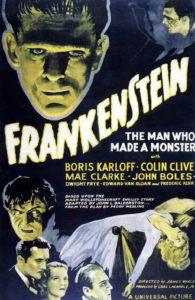 Thanks to my father’s love of the monster movies of his youth, I grew up watching horror films.
Thanks to my father’s love of the monster movies of his youth, I grew up watching horror films.
It started with the old Universal Pictures movies that were shown sporadically on channel 13, the PBS station out of NYC. One of the first I remember seeing, the lights dim in the living room, was the 1931 version of Frankenstein. (Along with Dracula and The Wolf Man, you’ve pretty much got the unholy trinity of classic monster movies.)
By today’s standards, the movie itself is tame. This is true of almost all of those classic films that set the groundwork for the horror genre of film. When it first came out, with popular movies being just shy of a generation old, many scenes in the film were shocking and some even found themselves censored from future releases of the film.
By now everyone knows the basic story told by the movie. It’s been done hundreds of times–in other movies, on many television shows, retold and reminagined in every medium that’s become available. At it’s core, it’s based on Mary Shelley’s novel of the same name which first came into print in 1818, and has spawned numerous sequels.
The Plot
The film plays out a little differently than the book it is based on. A good hunk of the story from the book doesn’t come into play until Bride of Frankenstein in 1935.
We are introduced to Henry Frankenstein, a young and ambitious scientist with some unorthodox ideas about life and death. Together with his hunchbacked assistant Fritz, Frankenstein cobbles together a monstrous body made from various corpses. Using the power generated from lightning, that gestalt form is brought to life.
The Monster is new to the world, mute and awkward in his movements. Quickly he begins to understand, but still lacks full comprehension of how fragile the other beings around him are. Henry is horrified by his creation, locking it away in a cell. Fritz taunts The Monster, inciting it to panic by thrusting a lit torch at it. That fear causes The Monster to break it’s chains, kill Fritz, and flee into the countryside.
Briefly, The Monster is recaptured and thought killed by Frankenstein, who then leaves to prepare for his wedding.
Townsfolk, already suspicious of Frankenstein’s activities, are further riled up when The Monster throws a little girl into a lake (ostensibly wondering if she’ll float like the flowers the two of them have been tossing into the water) where she drowns.
This would be where the now iconic torches and pitchforks come out and The Monster is chased to an old mill, which is subsequently set on fire, leaving everyone believing The Monster is, finally, truly dead.
Frankenstein recovers from his confrontation with his creation and proceeds with his wedding.
Why This Is A Classic
It’s more than just straight age that makes this movie a classic. If age alone were the determining factor, the first adaptation of the story from 1910 would be the gold standard. The Universal production, helmed by James Whale managed to hit at just the right time and did so with amazing (for the time) special effects and compelling acting (mostly from the then mostly unknown–despite the fact that he’d been in a number of films prior–Boris Karloff as The Monster) made this a hit with the public.
What really cemented this versions status as a classic, though, was its inclusion in the “Shock Theater” package of films that hit TV in 1957. This introduced a whole new generation to the film (and its sequels). Through this new distribution medium, Frankenstein (and many other of Universal’s films) became staples of Halloween and late night viewing. The rise of horror hosts like Zacherley is directly tied to Shock Theater and, while those presentations tended toward humor, the horror and philosophy of the films remained intact and caught the imaginations of thousands.
Intrinsically, Frankenstein is a fantastically made film for its day. It’s even one that deals with some relatively complex issues–literal matters of life and death, questions of just how far science should go, the idea of taking responsibility for actions, and some musing on man’s place in the universe. Plus it’s got an amazing monster. The makeup by Jack Pierce literally set the standard for decades to come.
Even though the film is technically an adaptation of an adaptation (having been adapted from a stage play based on the original novel), Whale still captures the essence of those deep questions. He would then go on to surpass this film in Bride of Frankenstein… but for a few years, much like Dracula, there was nothing better to be found that drew from the source material. Some would say that there still isn’t.
The Verdict
If you’re a fan of classic horror or film history and you haven’t seen Frankenstein, you absolutely need to do so. If you’re a student of film or culture, you also need to be familiar with not just the movie, but the way it influenced many things that came after it, as well as a large part of the youth culture of the early 60s.
Be aware that this is a film from a distinctly different time. The pacing, by today’s standards, is slow (though nowhere near as slow as some other films of the time), the acting is a bit stylized (more akin to classic stage acting), and the cinematography was limited by the technology of the time (shots tend to be much more static than we’ve become used to, without a lot of different cuts, zooms, or pans). The story itself still holds up, due in part to it’s stripped down simplicity.
If the thought of a movie done in black and white is beyond your capacity to even imagine… well, there’s nothing I can say that will make you consider this a good film. It’s definitely not for you. (And, with that mindset, you’re missing out on a lot.)
This has been and likely will always be one of my absolute favorite movies.

Leave a Reply